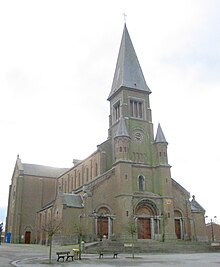Spy, Belgium
You can help expand this article with text translated from the corresponding article in French. (December 2020) Click [show] for important translation instructions.
- Machine translation, like DeepL or Google Translate, is a useful starting point for translations, but translators must revise errors as necessary and confirm that the translation is accurate, rather than simply copy-pasting machine-translated text into the English Wikipedia.
- Do not translate text that appears unreliable or low-quality. If possible, verify the text with references provided in the foreign-language article.
- You must provide copyright attribution in the edit summary accompanying your translation by providing an interlanguage link to the source of your translation. A model attribution edit summary is
Content in this edit is translated from the existing French Wikipedia article at [[:fr:Spy (Belgique)]]; see its history for attribution. - You may also add the template
{{Translated|fr|Spy (Belgique)}}to the talk page. - For more guidance, see Wikipedia:Translation.

Spy (Walloon: Spî) is a village of Wallonia and a district of the municipality of Jemeppe-sur-Sambre, located in the province of Namur, Belgium.

Here in 1886, in the Grotte de Spy or the Betche aux Roches cavern, Maximin Lohest and Marcel de Puydt found two nearly perfect Neanderthal skeletons (man and woman) at the depth of 16 feet (4.9 m), with numerous implements of the Mousterian type. Recently, Yves Saquet found a third skeleton of the same age.[1]
References
- ^ RTBF Belgian television news, 19.01.2010
External links
 Media related to Spy, Belgium at Wikimedia Commons
Media related to Spy, Belgium at Wikimedia Commons
50°29′N 4°42′E / 50.483°N 4.700°E / 50.483; 4.700
- v
- t
- e












